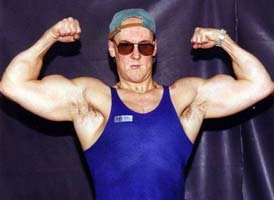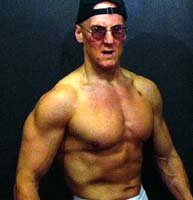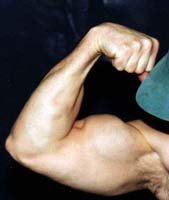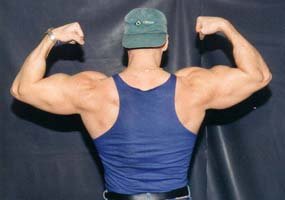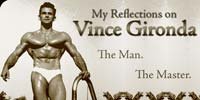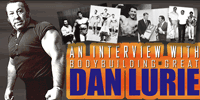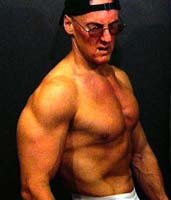Bodybuilding Myths Exposed: Dave Robson Interviews Randy Roach
In 1972, Randy Roach caught his first real glimpse of the kind of life he would pursue for the next 30-years. A newsstand publication featuring Arnold Schwarzenegger, Sergio Oliva and Dave Draper so grabbed Randy’s imagination, he made it his mission to learn all he could about this fascinating, emerging, sport of bodybuilding.
Although sufficiently motivated and enthused about his decision to become a weight trainer, Randy became increasingly disillusioned with the paucity of genuine nutritional and training information available to beginners like himself.
“This led many young aspiring bodybuilders to spend many years wallowing in training and nutritional ignorance. When you are in your teenage years, you read everything with the notion that all is true if it is in print. They just wouldn’t lie to us, would they?”During the 70’s there was good weight training information out there, however it just didn’t seem to surface as readily as the Weider publications,” says Randy.
Well, yes they would, and they did, and they still do.” It took Randy until his early 30’s, after much trial and error, to discover exactly what worked best for him. At this time, Randy made his best gains in muscle. He is still improving today.
Ever the experimentalist, Randy, during his quest for knowledge, uncovered many bodybuilding truths. He decided to become a personal trainer to help others cut through the mysticism he encountered.
Randy says of this process: “Not all was wasted; those years of reading and trial-and-error turned into an accumulation of experience and a degree in “been there, done it” that could be shared with others in the hope of sparing them the same paths that many of us had taken. After reading and trying as many training and dietary practices as I had, you are bound to stumble onto the truth at some point.”
Randy eventually graduated to building exercise equipment while developing a reputation as someone who gets the best from his clients. However, his real interest lies in nutrition, a subject he is intensely passionate about.
At 46, Randy considers himself to be in the best shape of his life. In the following interview, Randy shares many of the strategies he has used to get both himself and others in to tremendous shape. His ideas may shock some, but his success rate is hard to argue with.

[ Q ] Hi Randy. Could you give the readers some background on yourself? How did you get started in weight training?

A: I’ll be 47 this August 19th and was born and raised in Waterloo, Ontario Canada. I spent most of my career as a computer programmer developing software for various markets.
As for weight training, I remember seeing Dave Draper way back in the late 1960’s when I was just a kid. He appeared in the Beverly Hillbillies and the Monkees. He also had those ads where he had his arms stretched out to the sides showing the veins. It looked great.
My younger brother, Tom, used to have his own variation of Draper’s poses where he’d strike a classic shot, then throw out his belly. He was only a little kid and it looked hilarious. I still laugh when I think of that. You had to see it. He had it mastered!
I was one of those guys who bit in immediately. Loved every aspect of the sport. I was building benches at the age of 13. There are a number of guys in the industry who are into bodybuilding, equipment, martial arts and boxing. I was and still am one of those guys.
My eyesight pulled me out of the boxing and martial arts back in my teens, and basically filtered me strictly into weight training. This was fine with me. That is where I wanted to be. I would have thrived in this industry no matter what era I was born.

[ Q ] You mention being involved in weight training and its associated practices for over three decades. What have you learned over this time regarding what works and what does not?

A: As I mentioned, I was building benches at 13. I continued building all sorts of things from that point. Damn near killed some friends while I was at it. I am serious when I say I have been in it that long. Even though I was only a young teenager when I got started, I was beginning the trial and error process very early.
You’d think that I would have gathered knowledge quickly. The truth is that I was probably in my early 30s before my head popped up from south of the belt line.
I learned that genetics play a significant role, but they are not everything. Much can be attained with persistence, tenacity and good eating. I never inherited my Dad’s solid structure, my brother did, but he never took it past his Draper poses. I never gave up. I worked hard and made many mistakes. But I learned from them.
The Iron Game has splintered into so many factions that it confuses many people. The industry is so divided because of that. I guess it does serve the commerce and has provided some pretty good entertainment over the years. But the polarity has hurt us as well.
You can build strength and muscle many ways. As my friend, Jim Bryan says,

[ Q ] What interests you most about the iron game?

A:
- I’d have to say the nutrition most of all, followed by the sport’s history and the actual training. I used to like building equipment. Some of my stuff did actually turn out with a low mortality rate. I’ve been fortunate to meet Tyler Hobson of Pendulum Strength Training Solutions. He has quite a mind in this regard.

[ Q ] What are some of your current projects?

A: My main focus right now is on my book, “Muscle, Smoke & Mirrors.”

[ Q ] What kind of impact will your new book have on those who read it? Will any new facts be revealed? Can you share some of these?

A: I think it will have a tremendous impact. The book will be like no other in the game, at least not that I am aware of. It began as an article request from the Weston A. Price Foundation about four years ago. The article was published in 2004 as “Splendid Specimens.” It was substantially edited down.
They actually did a good job considering the amount of data I gave them. The article was fine for the general public, but so much of the context was removed, that I felt the bodybuilders may find it lacking. I was surprised when I found out how many were reading it and liked it.
The book is so much more. The project has been totally re-written from the first draft from which the article came. It is not an illustrated piece. There are already many out there in that style. Mine is going to be approaching 600 pages based primarily on a narrative format.
The by-line of the book is “Bodybuilding’s Amazing Nutritional Legacy.” The book title was originally, “The History of Nutrition in Bodybuilding.” Dr. Kaayla Daniels, who wrote “The Whole Soy Story,” feels I have a much bigger audience than I think and offered to write the back cover if I changed my boring title. So, that’s when I came up with “Muscle, Smoke & Mirrors.” The title truly reflects the nature of the industry.

[ Q ] When did you decide to make the project a book?

A: Originally, I had no intentions of writing a book. Ron Kosloff of NSP Nutrition asked way back if I was at least going to put it into a small pamphlet form and send it out. A couple of friends also hinted at perhaps doing something.
But, it was when interviewing Dr. Mauro Di Pasquale almost three years ago that he, right out of the blue, said, “This is going to be a great book!” I said, “No Mauro, it’s an article for the Price Foundation.” He just replied, “It’s going to be a book.” He agreed to write the foreword about a month or two later. He felt our industry needed this type of work. He has not seen it before.
Mauro’s a great guy and open minded. He’s going through some of the chapters now, preparing for the foreword. I was a bit concerned that he was an MD, and I cover much of the history of the philosophical divide between orthodox and alternative medicine.
You cannot look at the history of nutrition in bodybuilding without going into the roots of bodybuilding itself. That means going back through weightlifting into the origins of physical culture. Those early pioneers, in most part, practiced a holistic lifestyle emphasizing all aspects of health.
The ones that weren’t in the beer halls in most part, allied themselves with the alternative field of healing. Bernarr Macfadden led the way on this. Man, did he ever piss off the “Medical Trust” as he called them back then.
 |
||
| Bernarr Macfadden: Bernarr Macfadden (b. August 16, 1868, d. October 12, 1955) was an influential exponent of physical culture, a combination of bodybuilding with nutritional and health theories.He founded Physical Culture magazine in 1899, and later parlayed it into a publishing empire, including True Story, True Romances, the once-familiar movie magazine Photoplay, and a trashy tabloid newspaper, The New York Evening Graphic. At the peak of his career he owned several hotels and a major building in New York. He made an unsuccessful attempt to found a religion, “cosmotarianism,” based on physical culture. He claimed that his regimen would enable him to reach the age of 150. |
||
I write on this philosophical division, and the philanthropic intervention that seized control early in the century and set us on course for the health mess we are in today. There was a lot of activity going on back then, and our industry had many players and gurus who had their roles in shaping the game.
Sandow, Hackenschmidt, Strongfort, Calvert, Jowett, Berry, Hoffman, Weider, Lurie, Rader, Blair, Gironda, the list goes on. Lots of influence from outside in the field of nutrition research, the food industry, not to mention the politics within the Iron Game itself and the battles for control. Tons of stuff and tying it all together was very interesting.
As I stated earlier, I don’t think anyone has looked at the sport from this view before. I basically deal with all aspects of the industry. Bodybuilding itself had quite a struggle for its own identity. Then it had to break free from the shadows of weight lifting. The arrival of supplements was a financial saving grace that changed the game from a commercial perspective, for sure. And the drugs? Well, from physical culture to what we have today. The final fall.
I feel the book will resonate powerfully both in and out of the industry. Mauro would like to get it into four to six languages as soon as possible.

[ Q ] How hard was it getting people to contribute?

A: It was tough at first, since I was basically a nobody or no name in the business. Jim Bryan was already a friend and we talked for hours. He ended up opening a few doors. My biggest break was when Bill Pearl took me seriously and gave his time and name to use when trying to land others.
Slowly more came on board. After two years of lingering and pestering, others, I guess, began to realize I was really trying to produce something worth while and became quite generous with their time. After four years, I have made some good friends.

[ Q ] On a different note Randy, as a personal trainer, you are known as someone who gets excellent results. What, in your view, does a good personal trainer need to do to ensure a high success rate?

A: If it is simply a good success rate you are after, then the best thing to do is train only elite athletes or slightly overweight mesomorphs. You really can’t go wrong. Those guys and gals respond to anything.
Actually, as crass as that may sound, the approach does have to be applied at a more subtle level. Every trainer encounters the individual who you can sense within minutes is going to be a challenge, and in some cases, you know they will not make it. The psyche just isn’t there.
Having positively charged, motivated clients, plays a big role in whether you are successful. You find after a while that your enthusiasm becomes relative to that of your client. If a client is constantly negative, you have to make sure they don’t see the drain they are putting on you.
Your job is to try and turn that attitude around. Sometimes you can. Often it’s so entrenched, it’s hard. You have to determine how much energy you can afford. If there is constant negativity, then you are going to have unbalanced energy dynamics between the two of you. Too many clients of that nature per day will drain you.
You really have to have been in the business for a long time and understand the nature of exercise and health. Just knowing anatomy, physiology, and kinesiology is not enough. You must know how to apply them in terms of achieving a real harmony or good health.
It truly is an individual endeavor for each person. Different applications for the vast individuality out there. A client’s age, mental and physical constitution, biomechanics, lifestyle, desires, willingness, and personal histories all have to be looked at.
Today, it’s not simply a matter of trainers not knowing what they are doing, but more so, not understanding what they are doing. It’s not a matter of simply achieving a certain level of body fat or resting heart rate. That doesn’t always reflect good health or success. There has to be a harmony. Health is harmony on all fronts.
Training for athletics is different, especially at the pro levels. It’s no longer about health, just winning. As I said, those guys are relatively easy to train. The challenge is in the lower echelons of the genetic pool. That is where you are confronted with all the anomalies, physical and mental.
With all that, I still feel that nutrition is the priority. You can exercise until the cows come home, but if you are eating trash, or simply wrong for your body, you’re dead! On the other hand, history clearly shows that those eating superior diets without any type of 20th century fitness intervention had great health and longevity.
For general good health and well-being, I go with the Gironda line of 85 to 90% nutrition and the remainder exercise. However, for bodybuilding, I go with about 65 to 70 nutrition, especially if you are not genetically gifted for the sport.

[ Q ] What has enabled you to become a top trainer?

A: Usually, top trainers are associated with training pro athletes or celebrities for which I have none. But as I noted above, I wouldn’t mind at times since it would be easy. The pros are so gifted and the celebrities are extremely motivated.
My energy is primarily focused on my book and some of my own training experiments right now. So, I don’t carry a big training load. The clients I have are good. They don’t drain me. We have a good exchange of energy, and many make me laugh. In fact, some are quite gifted and motivated themselves.
I have a good understanding of what fitness truly is. My experience in nutrition is fairly extensive, due in most part to learning from my many mistakes. I also have a decent grasp of anatomy, physiology and biomechanics as they apply to exercise.
When dealing with the general public, it’s a matter of cultivating a healthy lifestyle. It begins with what you are putting in your mouth. I state again, nutrition is always first. Exercise alone will not do it. In fact, exercise could actually be detrimental.
If you are already in constant ill health, and are not willing to change your diet, which is usually the cause, then adding the stress of further exercise, will simply accelerate the degenerative process. If the diet could not sustain good health before, how could it possibly do so with more physical demand?
The challenge with most non athletes is getting them to change their lifestyle. Many love their social interaction, and often that incorporatesalcohol and junk food. You usually end up with compromise on both ends. They must end up with something that they can live with and won’t stress them out. And again, it’s an individual thing.
When there is a total dietary alteration, the turnaround can be extremely dramatic.

[ Q ] Your own physical development is pretty impressive. Describe the training and nutrition programs you use to get into top shape.

A: My slogan is, “When it comes to exercise and nutrition, I have basically done it all wrong at least twice.” That usually instills great confidence in my clients.
We can learn from the old timers as well. They really did know how to build strength and muscle – without DRUGS! Right now I am experimenting with cycling intensities and volume. I like cycling things on a weekly basis. I’ve been doing that with my diet for about 10 years.
Even though I am primarily a raw food eater, Di Pasquale and I basically see nutrition in a similar light. Mauro eats a fair amount of raw food also. I like his phase/shift approach.
I find that the raw food has made a big difference in my shape and health. I wish I had hooked into it decades ago. I did the vegan thing, but it was the meat I needed so badly. The raw beef, chicken, liver, and heart has agreed with me tremendously.

[ Q ] The raw meat will probably make many a little squeamish, especially the chicken. Do you feel raw meat is superior? What about salmonella poisoning associated with this practice? How do you reconcile this?

A: The raw meat makes everyone edgy as it did me several years back when Dr. Ron Schmid introduced me to it. I remember sitting down to eat raw beef for the first time. The meat was ground and mixed with eggs and cream. It was brutal. I thought there is no way we were meant to eat like this. Even if we were, I didn’t know how long I could tolerate it.
I was going to just drop it, but I got frustrated with myself for giving up so fast. The next day I tried it again without the cream and eggs. I just added a bit of sea salt. Huge difference. Still sucked, but I didn’t gag this time. But I remember thinking that if I could adapt that much in one day, then we can probably eat anything.
Since then I have come up with some recipes that make it quite tasty. I have also acquired a taste for it. It’s kind of like beer. Who ever loved their first taste of beer? Not many. I’ll only have my meat raw from now on unless I’m eating at a family gathering. Oh yes, my brother has started eating raw meat, also. He could be making a comeback!
We have all been indoctrinated with Pasteur’s theory of germs being the cause of disease. He wasn’t the only voice back in the 19th century – just the most politically connected. Others like Bechamp and Bernard opposed him vehemently. I cover some aspect of this debate in the book since many of the alternative practitioners sided against Pasteur.
I was just as paranoid as everyone else over the germ thing. It took me another year before I would eat the chicken. I finally gave in and realized I liked the taste of it raw better than cooked. What happened after was kind of funny, but boosted my confidence in the notion that Pasteur was probably wrong. Because of my eyesight, I would often leave chicken lying on the counter after cutting it up.
 |
||
| Louis Pasteur, Scientist: Pasteur is the 19th-century biologist and chemist whose work with germs and microorganisms opened up whole new fields of scientific inquiry, aided industries ranging from wine to silk, and made him one of the world’s most celebrated scientists.In 1854 Pasteur became a professor of chemistry at the University of Lille, and soon began studying fermentation in wine and beer. He became convinced that, as he put it in an 1878 paper, “the germs of microscopic organisms abound in the surface of all objects, in the air and in water.”He determined that such microorganisms could be killed by heating liquid to 55 degrees Celsius (about 130 degrees Fahrenheit) or higher for short periods of time. This simple process became known as pasteurization, a process used today in milk and many other beverages. |
||
I’d eat some, wash my hands, then walk away, not seeing that I left some on the counter. I was doing this quite often and throwing it out getting quite pissed. Finally, one day, I just said, “The hell with it. I’m eating it. What is our immune system for anyway?”
The chicken had sat out for about 8 hours and was actually starting to get crusty. I ate it all and had zero ill effects. In fact, I’ve not been sick once in the years that I’ve eaten raw. I have also eaten three-month-old, moldy berries. And while were at it, I’ve done my urine too. There, now you have it all!
The raw food health practitioners actually age meat for months to create all sorts of bacteria for various forms of disease fighting including very aggressive cancers. It’s called “High Meat”. The Eskimo also would ferment meat.
Raw is superior! It breaks down quite easily with far less stress on the digestive system. It comes with its own enzymes. Taken with raw honey, it is even better. The raw food researchers claim that the protein is far more available than when cooked. It’s common sense. You cook; you alter; you kill.
Many attack or brush this off because the thought of eating raw disgusts them. I was once there myself. I can’t believe how far I have come in attitude change. It’s just such a major difference in how I feel physically. It takes some time for the body to slowly rebuild.
You should hear Armand Tanny when you talk to him about his raw meat. You can almost hear him salivating over the phone. Armand said he didn’t need any steroids with all the raw protein and creatine he was getting. He was quite big and hard in 1949 and 50 when he won the USA and Pro America.
Gironda too ate tons of raw eggs, cream and meat periodically. They knew what worked. One of my five chapters on the 1960s is called, “Muscle, Cows, And Chickens.” This was my favorite decade. It was classic bodybuilding. Yeah, they had drugs, but not all were abusing them, and many weren’t taking drugs at all.
These guys definitely knew the proper application of the cow and chicken. They were tuned into muscle building. Howorth, Draper, Scott, Mackey, Gajda, Balik, Green, Peters and many more.
Our industry had a lot of good solid voices during the 20th century, while the rest of the general public was being duped. Unfortunately, many of the bodybuilders, not all though, were also misled when North America went astray during the 70s and 80s fitness boom.

[ Q ] Can you elaborate?

A: We were basically led down the cardio and low fat bullsh*t trail. I cover the history and rise of the Lipid Hypothesis in my book. That is the notion that cholesterol and saturated fat caused heart disease and almost everything else. Man, that nonsense did and still is doing a lot of damage! Made some industries piles of money, though.
Many strength performance researchers believe that we really lost it to the Eastern bloc countries when we went on the running and cardio craze back in the late 60s. Again, it was driven by people who didn’t understand what good health really is.
Many of the conclusions reached on both the nutrition and exercise fronts are being reversed or seriously revisited. Too much emphasis on exercising the heart believing it is the secret to longevity.
I get everything I want for myself in terms of health and harmony through diet and weights. I’m on the spin bike twice a week for five minutes of sprints. The rest is all weights. Right now I am striving for more muscle. So, I’m doing some interesting things that would probably invoke criticism from some of the bodybuilding factions.

[ Q ] Would you care to expand on that?

A: No, not right now. I’m still trying things out. As I said earlier, the old timers knew how to build muscle. You can’t spend the number of hours on this history as I have and not come away with a few things. I cover more than just the nutritional legacy of the sport, but also the philosophical splits in training.
With all the factions, there was a lot of confusion, and some of the magazines made it worse. Arthur Jone’s arrival and Mike Mentzer later on, again, just added to the confusion.
I really don’t discuss my training to much outside my circle at my gym. Fred Fornicola from New Jersey is one of the few who keeps tabs on what I am doing. He’s a HIT guy with an open mind. Makes me think, sometimes more than I care to. He and Matt Brzycki just put out a book, “Dumbell Training For Strength And Fitness.”

[ Q ] You lost your sight last year. How did this happen and what impact has it had on your writing and training?

A: Actually, I’ve had eye issues going back to 1961 when I had Steven Johnson Syndrome (SJS) at the age of two. The troubles escalated in my 20’s, but I still remained functional. I had experienced short periods of blindness here and there over the years, but just over a year ago, I began staring at a white wall.
The training wasn’t a big deal other than the massive beatings I was taking in the gym from running into things. I finally started using my white cane. This wasn’t a big shock to me. I was expecting this to happen, but I thought it would be another 10 years. I prepared early by building my customized home with a world class gym in the basement. I have about 1200 square feet of training space.
Fortunately, I worked for a great company that helped me transition out of computer programming into what I am doing right now. YMCA Canada has also been very supportive in coming to my place for the recertification process. They were a little concerned as to how I could monitor motion and progress as a blind guy.
I found that I am probably a better trainer using hands on than I was before. I just have to be careful. I have already grabbed one guy’s @ss!
My family and friends have been great. My Mom is a real trooper and still does quite a bit for me, as did my Dad before he passed away a few years ago. He was a great welder. As for the book, that was a challenge. It was very frustrating. Initially, lots of foul language and tossing a few things.
My good friend and editor, George Harrod, really stepped up to the plate for me. George is not a bodybuilder. He is more of an historian who has taken a keen interest in this project. In fact, I think he is into it almost as much as I am. He and another good friend, Moira Dunn, have read for hours to me.
It’s kind of strange when you come into my place. You just see this blind guy surrounded by books and magazines from all through the 20th century. I don’t know what the mail woman thinks when she delivers all these books and mags from Bob Adams and I can’t even see to sign for them, let alone read them.
Another good friend, Tamas Acs of “Acs Fitness”, has also helped me tremendously with the online searching and things of that nature.
I am currently trying to upgrade my voice software, scanner, and scanning programs to bring in much more material. I’m moving along.

[ Q ] You have researched heavily the impact certain diets have on certain populations. Is there a perfect diet? What are some guidelines we should all follow?

A: A diet that gives one a long, disease-free life of happiness I guess could be considered a perfect diet. You can have a great looking physique, but without harmony, there is no happiness, without happiness, there will be eventual collapse on either or both the physical and mental fronts. These breakdowns begin when the diet is not sound.
Yes, I have looked and tried so many things over the years including vegan vegetarianism. The macro nutrient balance can vary from person to person. I personally do much better on low carbs. The bottom line is that we eat too much sh*t. There is no better word to use, because that is what we are eating.
We’ve lost the understanding of the power and vitality contained in fresh, natural and raw foods. Diet has been relegated to such a low priority. Keep the grocery bill down, so we can buy other useless items. Our food supply is being trashed through mass industrialization. We let it happen for all the wrong reasons. Weston Price‘s landmark work, “Nutrition and Physical Degeneration” says it all just in his title alone.
Neither drug nor natural competitive bodybuilding are synonymous with good health. The drug regimens are insane, but the naturals are almost as bad in some cases. The diet and supplementation regimens they are using are not even close to being natural.
I remember back in the 90s reading some of the supplement regimens when pro hormones were still legal. It was such a rap sheet I thought, “Man, why not just do a round of dianabol and get it over with? It’s cheaper. It works, and is probably safer.”
Don’t get me wrong, I take a few supplements myself and have good friends in the supplement industry, but they know how to use them properly, along with a decent diet. In fact, the honest ones will tell you themselves that supplements are not of much value if your diet sucks.
Many of the naturals are living off totally processed diets even if they buy the bulk of their stuff out of a nutrition depot. The vitality is gone. It’s a slow degenerative process. Some are stronger and more resilient than others. And the drug guys, they’re downing cake mix to work with their insulin shots.
If only a percentage of the movie Super Size Me is true, then it’s a total indictment of our health-governing bodies. That they should allow a nutritionally abysmal environment to flourish is a testimony of their total ineptness. How did this happen? Was it plain stupid or corrupt, or both?
Take your pick. Either way, billions have been made because of this direction. Every bad decision regarding our food supply always seems to have resulted in a coincidental, enormous cash flow for some aspect of industry.

[ Q ] Who in bodybuilding do you admire and why?

A: Well, you have to admire guys like Jack la Lane and Armand Tanny. They are going strong at 91 and 87 respectively I believe. I’m kind of partial to Tanny since he is a raw meat eater.
There are a lot of guys whom I admire what they do even if it’s not my thing. I admire anyone who is still plugging away in the industry in an honest way and believes in what they do. I have all sorts of friends representing all facets.
I speak often with Jim Bryan who was close to Arthur Jones way back, Fred Fornicola who runs the on-line, High Performance Newsletter, and Tyler Hobson of Pendulum who may even be better than Arthur Jones with strength curve technology. Ron Kosloff of NSP Nutrition, who is a huge Gironda supporter.
| RELATED ARTICLE | ||
|
Don Howorth has a story that should be told. Bob Gajda and Terry Strand in Chicagoland have been great supporters. Gajda is hilarious to talk with and the guy is still sharp and thinking at 65. Even good, old Dan Lurie. I told him, I thought he was dead! I respect all these guys and several more I probably forgot to mention.

[ Q ] What do you think of the physiques of today compared with those 30-40 years ago?

A: Pretty well the same as everyone else – not much. I have nothing against the guys, just don’t like their physiques. Their look, and how they attained it, represents a gross departure from any essence that bodybuilding or physical culture ever possessed There’s even an enormous change from as late as 1992. Look at the 92 Mr. O and then anything after. You’ll see exactly when the GH, IGF-1, and insulin erupted.
Almost no one likes this look. Even the homosexual audience is dwindling, I hear. Now that alone should be a flag! Everyone liked the aesthetics and individuality of the older days. It’s amazing how they just threw stuff likesymmetry right out the window.

[ Q ] What are your views on drug use in bodybuilding? Should it continue to ensure the freakier physiques continue to populate the stage, or would a return to a more realistic look be better?

A: Well, I’ll continue from the previous question. Top pro bodybuilding isn’t really bodybuilding anymore. It’s something else. Call it what you want, it’s dying. Avenues necessary to attain such a look are outrageous and most won’t go there. Those who do are real chemical pioneers as far as what the body can withstand.
In fact, genetics may not even be the dominant factor anymore. It’s more like, “Who is the bravest?” “Who is the best chemist?” and “Who can sculpt with Synthol most effectively?”
I hear the magazine sales are falling, attendance is dropping off, and the sport is losing young talent because of the reduced number of teenagers entering the amateur ranks. As Wayne DeMilia told me, “Who would want their kid in the sport at this stage anyway?”
There will always be a small faction who just like to do the crazy thing or get the crazy look. But the sport is better than this. Contrary to what many think, there are a lot of good people in the industry. The sport is always hungry for money and media attention. It will follow the money and attention. We just need people to take it in a new direction. And we may be at that time.
DeMilia is giving it his best shot with Pro Division Inc. which was just announced recently. No one can say he can’t run a bodybuilding show. But we can certainly say that AMI and the IFBB sure as hell can’t. That last Mr. O was terribly produced. I piped it in with some friends. I couldn’t believe what I was hearing and they couldn’t believe what they were seeing.
I have spoken for several hours with DeMilia. I don’t know him personally, but he strikes me as a man who truly wants to reel the sport back to a reasonable path. He has the experience, and more loyalty than most people realize. He should be supported. I like his plan. He will operate in a professional manner. The IFBB has failed professional bodybuilding. They have had their run. Talk about smoke and mirrors…
Even Sealtest Dan, the Muscle Man is donning his cape and making a comeback. The old bugger is going to be 83 I believe and still wants to have some fun. That’s Dan Lurie for any of your readers who are younger than 60. He is teaming with Steve Speyrer and Alan Palmieri and the 3 are launching a big collector’s edition of Lurie’s “Muscle Training Illustrated.”
I believe there are plans of resurrecting the World Bodybuilding Guild also. Never count out Dan Lurie, he’s a winner. Next time you talk with him, ask what happened to all his muscles. You’ll love his response.
Anyway, people are just fed up with what they are seeing. Who knows, the sport could be governed by entirely different hands in 5 years.
| RELATED ARTICLE | ||
|

[ Q ] What have some key moments in your life?

A: I’d say the past year has been a key moment in my life. I have met some significant people, some of whom wish to remain nameless. Landing my programming position with Conestoga-Rovers in 1993 was a key moment, as was building the home I live in now in 1999.

[ Q ] What else would you like to achieve Randy?

A: Considering the process I went through over the past year, I don’t feel that outside of the book’s completion, there is anything that I actually need to accomplish. As bizarre as it may sound, it turned out to be the greatest year of my life, sight or no sight.
I’m currently at my best, physically, mentally, and spiritually. It’s called “physical culture.” God willing, you’ll read what happened to it in my book. There is much more to say.
Visit Randy at: www.prfit.com.
For information on his book Muscle, Smoke and Mirrors visit:www.musclesmokeandmirrors.com

